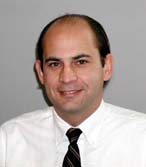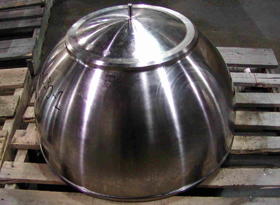Meet the IBEX Team: Howard Runge

At first glance, space science and basketball don't seem to have a lot in common. But Howard Runge, the Orbital Sciences project manager for the IBEX mission, sees a connection between managing a successful space mission and playing on a sports team.
"There is a strong need for coordination, communications and working together as a team on a space science missions," Howard said. "When you study a technical discipline in college, it tends to be more of an individual rather than a team pursuit. After college when working on a real space science mission, there are many technical disciplines required to design and build the spacecraft and science instruments. So it becomes really important to work effectively in a team environment."
Howard honed both his engineering and teamwork skills as an engineering major and member of the basketball team at the Massachusetts Institute of Technology (MIT). "I played on the basketball team in college at MIT, and of the various things I learned there were people skills that I've needed to manage the IBEX project," he said.
He puts those skills to practice while overseeing the team of engineers who design and build the spacecraft and and solid rocket booster that will lift the IBEX spacecraft into orbit through a series of propulsion maneuvers. First, the Pegasus rocket takes the spacecraft into a low orbit. Immediately after IBEX separates from the rocket, it will fire a solid rocket motor to boost the spacecraft into a "highly elliptical" orbit. Over the next few weeks, Howard's team will boost IBEX into its final science mission orbit using the spacecraft's hydrazine propulsion subsystem. IBEX's final mission orbit has a 7000 km perigee altitude and a 50 Earth-radii apogee altitude (about 80% of the distance between the Earth and the Moon).
This month, Howard and his team have been busy preparing to present their spacecraft subsystem designs at engineering peer reviews. These reviews lead up to the IBEX Critical Design Review in September, and will ultimately ensure that the mission goes smoothly.
Howard wasn't always interested in using his engineering skills for space exploration. As a child growing up in northwest suburban Chicago, he loved shooting off model rockets, but was more interested in exploring the sea. "I was a very big fan of Jacques Cousteau, which led me to go off to MIT as an undergrad and major in ocean engineering," he said.
In choosing an engineering career, Howard was following in his father's footsteps. "Growing up, I was inspired by my dad, who was also an engineer, and he was good at designing machines and finding practical engineering solutions to technical challenges," he said. It also was a natural extension of his early love of model rockets. "I did enjoy building and firing lots of model rockets when I was a kid, and now I get paid to do that, which is a good thing!"
After working for an offshore oil company, Howard started work as a mechanical design engineer for an aerospace company that made hydrazine propulsion systems. This was back in the "drafting board days", when engineering drawings were made with pencil and paper instead of computers. While working in this position, he learned more about spacecraft engineering when building propulsion systems for NASA science spacecraft and by earning a master's degree in mechanical engineering at the University of Connecticut. After completing this degree, he began working at Orbital 19 years ago. Originally, he helped create rocket systems to launch satellites from the space shuttle and assisted in the early design of Orbital's Pegasus launch vehicle, which will be used to launch IBEX.
As part of the original team that developed the IBEX spacecraft design concept, Howard began work on the mission well before it was an official NASA mission. "One of the major challenges was that IBEX was a competitively selected mission, and we had to win the NASA contract against around 25 other missions," he said. IBEX was one of two Small Explorer (SMEX) missions selected by NASA, but the second mission was recently cancelled due to NASA budget constraints. "Now, our challenge is to do a good job on the spacecraft design, manufacturing and test program, and keep it sound from a cost and schedule perspective," he said.
For Howard, that challenge is an enjoyable one. "I think the best part [of the job] is being able to oversee and coordinate the big picture of the program. I'm in a position to make major decisions about the spacecraft, so I like seeing how the overall different pieces fit together in helping to manage it in a way that comes up with good practical design and operational approach. I also like the people contact - helping younger engineers who are getting larger and larger responsibilities to grow and mature and accomplish more in their jobs than they have done in previous positions," he said.
Howard believes that finding a mentor is one of the keys to having a successful career in space science. "I would suggest that [students interested in space science careers] get a good solid education in all the fundamentals: math, science, physics and English, and try to take as much advanced course work as possible. I'd also encourage them to find mentors who can help them develop in their educational and career goals, and share their experience. Also look for ways to get team work experience from activities such as sports teams and service organizations" he said.
In addition to mentoring younger engineers, Howard also enjoys spending time with his wife Carol and their three children: Cathy, who just graduated from college; Stefan, age 9, who was adopted from Moscow; and Jesse, age 2, who was adopted from Guatemala. When he's not busy with work and his energetic boys, Howard likes to jog, swim, watch car racing, and of course, maintain his teamwork skills by playing basketball!
